calsfoundation@cals.org
Arkansas State Hospital
The Arkansas State Hospital is the only state-owned and -operated facility for the treatment of mental illness in Arkansas. The structure, function, and name of this facility have changed with the development of new technology and more progressive views for treating individuals suffering from mental illness, epilepsy, birth defects, learning disabilities, and the effects of old age.
The Arkansas Lunatic Asylum was created by legislative act in 1873. In 1905, the name was changed to Arkansas State Hospital for Nervous Diseases; it was changed to Arkansas State Hospital in 1933. A facility known as the State Hospital still exists today, but what was historically encompassed by the “State Hospital” is now part of the Division of Behavioral Health Services of the Arkansas Department of Human Services, though many people still refer to it as the State Hospital
In 1873, $50,000 was appropriated by the state legislature for the purchase and construction of a facility for the care and treatment of the mentally ill in Arkansas. The purchase of a plot of land west of Little Rock (Pulaski County) took most of the original appropriation. The Brooks-Baxter War and political wrangling about the planned location of the facility delayed any further action until 1881.
In 1881, the legislature levied a one-mill tax on all property in the state for two years and created an appropriation of $150,000 for the construction, outfitting, and operation of the asylum.
The asylum opened officially on March 1, 1883, with Dr. Chastaine Caldwell Forbes as superintendent. The first patient had actually been admitted by legislative order a few days earlier. Over the next few decades, a pattern of overcrowding and expansion emerged. As the available space was filled, the legislature was convinced to provide for the construction of additional facilities. By 1915, there were twelve buildings housing patients at the Little Rock site. In the 1930s, a hospital farm was established at Baucum (Pulaski County), where some of the more physically able patients were employed in the operation of a dairy farm. There were about 100 inmates to start with at the farm. By 1936, the need for further expansion prompted the opening of the Benton Farm Colony, as it was then called. It was planned to hold about 2,000 inmates. In 1957, due to changes in what was thought appropriate in the care of the inmates, the legislature ordered the cessation of all farm operations.
After almost eighty years, many of the original buildings were becoming dilapidated, and there were calls to replace the structures. In 1960, $6 million was appropriated for the renewal of the Little Rock facilities, and then in 1964, a federal grant of $291,950 was acquired for the updating of the Benton Unit (now the Arkansas Health Center). The Little Rock facility, in use as part of the Division of Behavioral Health Services, was replaced in 2008 with a 130-bed, 152,000-square-foot building adjacent to the campus of the University of Arkansas for Medical Sciences (UAMS). The old facility was replaced after mental health advocates complained about it being inadequate for the proper treatment of the mentally ill. In April 2011, the federal Center for Medicare and Medicaid Services cited the Arkansas State Hospital with an “immediate jeopardy finding”; five months before that, in November 2010, the same agency had found the hospital to be out of compliance with several requirements for psychiatric hospitals.
Many notable Arkansans contributed to the advancement of this institution. The Honorable Hiram Marion McVeigh drafted the original legislation that created the Arkansas Insane Asylum. Chastaine Forbes was the first superintendent, and Dr. Philo Hooper served as an original board member from 1881 to 1893 and as superintendent from 1896 to 1901. His own wife later became an inmate of the hospital. Dr. Elizabeth Fletcher became the first female physician at the hospital in 1936 and spearheaded much advancement in the care of mentally disabled children.
For many years, this was the only facility in Arkansas for dealing with people who, in modern times, would be sent to nursing homes, special schools, and rehab centers. Advancements in the medical community’s knowledge about vaccinations, prenatal care, and pharmaceutical treatments have caused the Arkansas State Hospital to change and develop. The hospital now maintains more of a focus on the treatment of the mentally ill, with the plan to get them back into society.
For additional information:
Annual and Biennial Reports of the Arkansas State Lunatic Asylum and Arkansas State Hospital. Arkansas State Archives, Little Rock, Arkansas.
Arkansas Lunatic Asylum: Arkansas’s Forgotten Asylum. https://arkansaslunaticasylum.wordpress.com/ (accessed July 28, 2023).
The Ben Rock Times (Little Rock). State Hospital Newsletter, June 1965–August 1973. Arkansas State Archives, Little Rock, Arkansas.
Hampton, Ashan R. “History of the Arkansas State Hospital.” Pulaski County Historical Review 43 (Spring 1995): 2–18.
Hanley, Ray. “From the Inside.” Arkansas Democrat-Gazette, August 22, 2021, pp. 1H, 6H. Online at https://www.arkansasonline.com/news/2021/aug/22/from-the-inside/ (accessed July 28, 2023).
Scrapbooks of the Arkansas State Hospital, June 1958–October 1968. Arkansas State Archives, Little Rock, Arkansas.
Shores, Elizabeth F. “‘Idiots and Imbeciles’: Children with Mental Retardation and Arkansas State Hospital, 1883–1958.” Pulaski County Historical Quarterly 44 (Spring 1996): 2–20.
April Goff
Arkansas History Commission and State Archives
 Arkansas Insane Asylum
Arkansas Insane Asylum 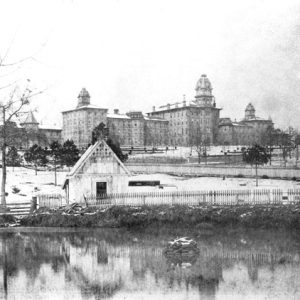 Arkansas State Hospital
Arkansas State Hospital 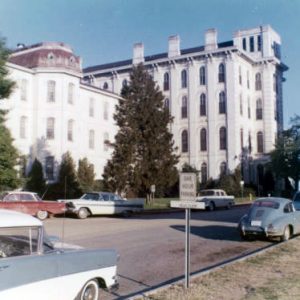 Arkansas State Hospital
Arkansas State Hospital 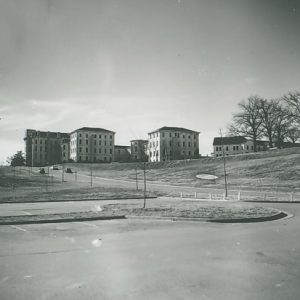 Arkansas State Hospital
Arkansas State Hospital 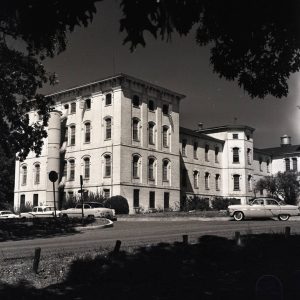 Arkansas State Hospital
Arkansas State Hospital 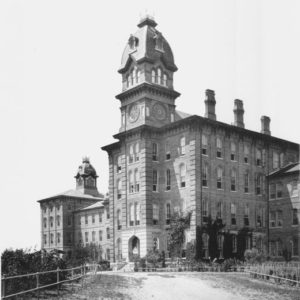 Arkansas State Lunatic Asylum
Arkansas State Lunatic Asylum 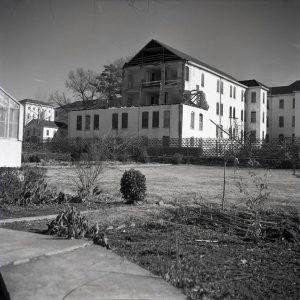 Building Demolition
Building Demolition 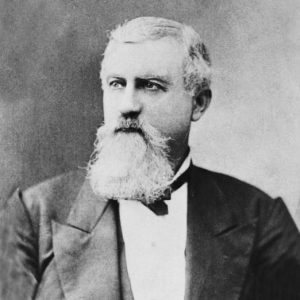 Chastine Forbes
Chastine Forbes 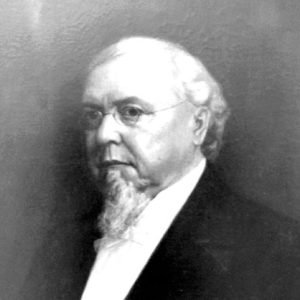 Philo Hooper
Philo Hooper 




The neighborhood I lived in in Little Rock as a teen was next to the site of the original Arkansas Lunatic Asylum. Our neighborhood was built on the site of the graveyard; the former homeowner confirmed that the bodies were moved, as she (and many children) watched the corpses being loaded onto trucks. I found an old gravestone in 1984 buried in a section of woods next to my street.
Our neighborhood was also built from the bricks of the asylum. My mom was convinced our house was haunted because of it, but she also had two mischievous boys in her house, so the “hauntings” MIGHT have been us messing with her.